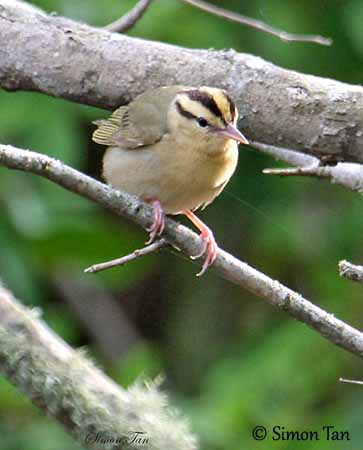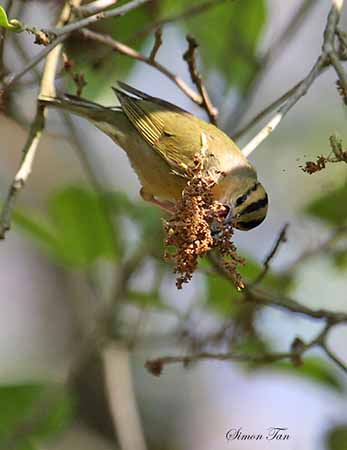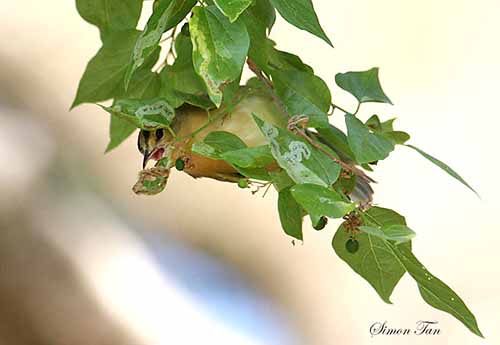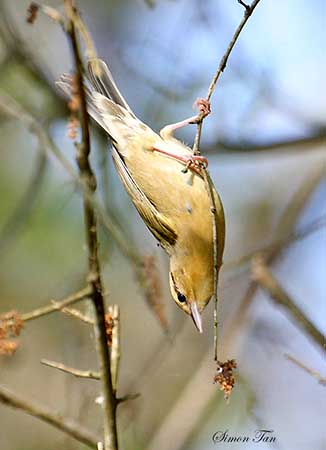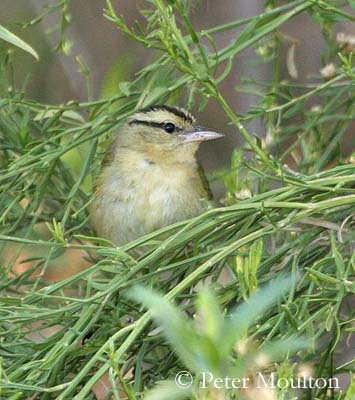
Worm-eating Warbler
Helmitheros vermivorum
Passeriforme Order – Parulidae Family
BIOMETRICS:
Length: 11 à 13 cm
Wingspan: 20 cm
Weight: 12 à 14 g
LONGEVITY: Up to 7 years
DESCRIPTION:
Worm-eating Warbler is the only warbler species in the genus Helmitheros.
Adult has brownish-olive upperparts, without any wing bar or tail spots.
Underparts are buffy, more orange-buff on throat. Undertail coverts show dusky centres.
Head is buffy, with conspicuous black stripes on crown and through the eye. Pointed bill shows dark upper mandible, and pinkish lower mandible. Eyes are dark brown. Legs and feet are pinkish-brown.
Both sexes are similar.
Immature resembles adults.

VOICE: SOUNDS BY XENO-CANTO
Worm-eating Warbler’s song is a high-pitched trill. Song may vary regionally. Flight song is much rapid, similar to buzzy twittering.
Worm-eating Warbler utters two different calls. A sharp, dry “chip” as contact call between two birds, or when predator approaches the nest. During nesting period and activities, members of a pair give frequently some “tseet”, mainly by female bringing nest material.
HABITAT:
Worm-eating Warbler lives mainly in dense undergrowth on wooded slopes. It breeds in mature forests with dense understory, and it winters in tropical forests.
RANGE:
Worm-eating Warbler breeds in south-eastern United States, in dense deciduous forests. It winters in Central America and Caribbean.
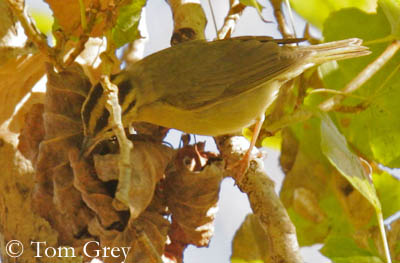
When male is establishing its territory, it can be aggressive, pursuing neighbours and chasing them, trying to peck each other. Usually, males fight more often than females. Breeding territory is established by male by singing from perches after arriving on breeding areas.
Worm-eating Warblers are monogamous. Female solicits copulation by spreading and drooping wings, with tail cocked upwards. Copulation occurs usually in subcanopy, on small branches.
Worm-eating Warbler is migratory. They travel by night, probably long distances.
FLIGHT:
Worm-eating Warbler performs direct flights within canopy. Before or after a fight, male may use fluttering flight, in aggressive behaviour. It can hover in order to capture flying insects.
REPRODUCTION:
Worm-eating Warbler female selects the nest-site within the male’s territory, usually the same site year after year. Female builds the nest alone, but male remains nearby. Nest is placed near water, stream or wetland.
Nest is situated on the ground, on hillside or bank. It is often well hidden among vegetation, against roots, beside rock ledge, or in dense low shrubs.
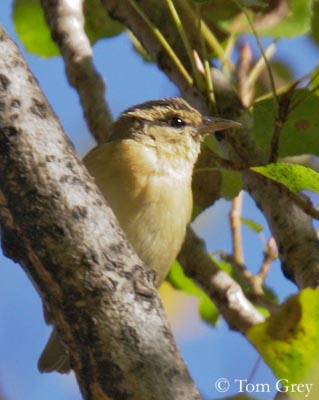
Female builds the nest, first by forming the cup with pliable leaves. She performs repeated trips with leaves, and she moulds them into the cup. Then, interior is lined with fine stems or moss. She may add hair and pine-needles, soft grasses and horse hair.
Female lays 4 to 5 white or pinkish eggs with brown markings. Incubation lasts about 12 to 14 days, by female. Male feeds her at nest during this period.
If parents are disturbed at nest, they begin Distraction Display, with spread wings and fanned tail, both depressed, uttering alarm call “chip”, or they only flutter across the ground until intruder moves away from the nest.
Fr: Paruline vermivore
All : Haldenwaldsänger
Esp : Chipe Gusanero
Ital : Mangiavermi
Nd : Streepkopzanger
Russe : Настоящая червеедка
Sd : Beigebrynad skogssångare
Photographs by Tom Grey
Tom Grey's Bird Pictures
Photograph by Pete Moulton
Pete Moulton Photography
Photographs by Simon Tan
PBase Bird galleries
Text by Nicole Bouglouan
Sources:
FIELD GUIDE TO THE BIRDS OF NORTH AMERICA by National Geographic Society - National Geographic Society - ISBN: 0792274512
A GUIDE TO THE BIRDS OF MEXICO AND NORTHERN CENTRAL AMERICA by Steve N. G. Howell, Sophie Webb - Oxford University Press - ISBN: 0198540124
All About Birds (Cornell Lab of Ornithology)
Wikipedia (Wikipedia, The Free Encyclopedia)
What Bird-The ultimate Bird Guide (Mitchell Waite)
South Dakota Birds and Birding (Terry L. Sohl)
SORA Searchable Ornithological Research Archive (Blair O. Wolf)
Chicks are altricial, with brownish-grey down growing two days later. They are brooded by female for the five first days. Both parents feed the young and clean the nest, removing fecal sacs.
Young fledge at about 10 days of age, and they remain with parents for about three weeks after fledging, in shrub and subcanopy.
This species produces only one brood per year, sometimes more if first is destroyed or lost.
DIET:
Worm-eating Warbler feeds mainly on caterpillars, insects and spiders, according to the season. It also consumes slugs.
PROTECTION / THREATS / STATUS:
Worm-eating Warblers are mainly threatened by habitat loss, due to fragmentation and destruction of forested habitats, and human developments.
They are preyed upon by mammals and snakes when at nest. Corvids can take eggs and nestlings.
Nest can be parasitized by Brown-headed Cowbirds in fragmented forests.
However, at this moment, Worm-eating Warbler’s populations seem to be stable across United States.
